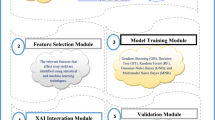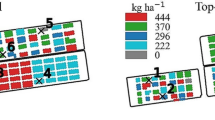Abstract
A number of biometric evaluations are performed during harvest for measuring the growth and development of the sugarcane crop. From these evaluations, hundreds of data values are generated, containing certain information on the productivity of the culture in that crop and edaphoclimatic region. Accordingly, the objective of this work was to identify, using a decision tree classification technique, the biometric attribute having the greatest effect on the productivity of the plant cane in different planting configurations and edaphoclimatic conditions. To accomplish this, data were evaluated from four experiments with sugarcane, located within the São Paulo municipalities of Teodoro Sampaio, Guaíra, Iracemápolis, and Lençóis Paulista. The classification model was generated using the decision tree technique, a type of intuitive learning that creates a hypothesis based on particular instances that results in general conclusions. The decision trees applied to the data of the four sites showed that the population of plants per hectare has the highest information gain (split attribute) on the class attribute (productivity). Using the “Chi-square” method of attribute selection, the population of plants per hectare was observed to have the largest correlation with the final productivity of the culture. Therefore, the decision tree indicates that the attribute “plant population per area” should be used as the method to evaluate the productive potential of the culture during its growth cycle. It has the best correlation with the final productivity of the crop, in addition to being an attribute easy to measure in the field.


Similar content being viewed by others
References
Beadle, C.L. 1985. Plant growth analysis. In Techniques in bioproductivity and photosynthesis, 2nd ed, ed. J. Coombs, D.O. Hall, S.P. Long, and J.M.O. Scurlock, 20–24. Oxford: Pergamon Press.
Cabena, P., P. Hadjinian, R. Stadler, J. Verhees, and A. Zanasi. 1998. Discovering data mining: From concept to implementation, 1st ed. Upper Saddle River, NJ: Prentice-Hall Publishing.
Cavalett, O., T.L. Junqueira, M.O.S. Dias, C.D. Jesus, P.E. Mantelatto, M.P. Cunha, H.C.J. Franco, T.F. Cardoso, R. Maciel Filho, C.E.V. Rossell, and A. Bonomi. 2012. Environmental and economic assessment of sugarcane first generation biorefineries in Brazil. Clean Technologies and Environmental Policy 14: 399–410. doi:10.1007/s10098-011-0424-7.
Cohen, J.A. 1960. A coefficient of agreement of nominal scales. Educational and Psychological Measurement 20: 37–46. doi:10.1177/001316446002000104.
Dalchiavon, F., M.P. Carvalho, R. Montanari, M. Andreotti, and A.R. Panosso. 2014. Produtividade da cana-de-açúcar: variabilidade linear e espacial entre componentes tecnológicos e da produção. Bioscience Journal 30: 390–400.
Dias, F.L.F., J.A. Mazza, S. Matsuoka, D. Perecin, and R.F. Maule. 1999. Productivity of sugarcane in relation to climate and soils of the northwestern São Paulo state. Revista Brasileira de Ciência do Solo 23: 627–634. doi:10.1590/S0100-06831999000300016.
Ehsanullah, K.J., M. Jamil, and A. Ghafar. 2011. Optimizing the row spacing and seeding density to improve yield and quality of sugarcane. Crop and Environment 2: 1–5.
Elmasri, R., and S.B. Navathe. 2005. Sistemas de Banco de Dados, 4th ed. São Paulo, SP: Pearson Education.
Fernandes, J.L., J.V. Rocha, and R.A.C. Lamparelli. 2011. Sugarcane yield estimates using time series analysis of spot vegetation images. Scientia Agricola 68: 139–146. doi:10.1590/S0103-90162011000200002.
Ferraro, D.O., D.E. Rivero, and C.M. Ghersa. 2009. An analysis of the factors that influence sugarcane yield in Northern Argentina using classification and regression trees. Field Crop Research 112: 149–157. doi:10.1016/j.fcr.2009.02.014.
Marin, F.R., R.V. Ribeiro, and P.E.R. Marchiori. 2014. How can crop modeling and plant physiology help to understand the plant responses to climate change? A case study with sugarcane. Theoretical and Experimental Plant Physiology 26: 49–63. doi:10.1007/s40626-014-0006-2.
Miller, D., J. Mccarthy, and A. Zakzeski. 2009. A fresh approach to agricultural statistics: Data mining and remote sensing. In 2009 joint statistical meetings, 3144–3155. American Statistical Association, Washington, DC.
Nonato, R.T., and S.R.M. Oliveira. 2013. Data mining techniques for identification of sugarcane crop areas in images of Landsat 5. Engenharia Agricola 33: 1268–1280. doi:10.1590/S0100-69162013000600019.
Pawar, M.W., D.B. More, V.T. Amodkar, and J. Snehal. 2005. Effect of intersettling spacing on sugarcane yield and quality. Sugar Tech 7: 87–89. doi:10.1007/BF02942424.
Quinlan, J.R. 1993. C4.5: Programs for machine learning, 1st ed. Burlington, MA: Morgan Kaufmann Press.
Singels, A., and M.A. Smit. 2009. Sugarcane response to row spacing-induced competition for light. Field Crop Research 113: 149–155. doi:10.1016/j.fcr.2009.04.015.
Singh, N.P., R.D.N. Verma, R.G. Singh, and S.B. Singh. 2000. Effect of plant geometry and nitrogen level on yield and juice quality of sugarcane. Sugar Tech 2: 40–43. doi:10.1007/BF02945743.
Witten, I.H., and E. Frank. 2005. Data mining: Practical machine learning tools and techniques, 2nd ed. Burlington, MA: Morgan Kaufmann Press.
Witten, I.H., E. Frank, and M.A. Hall. 2011. Data mining: Practical machine learning tools and techniques, 3rd ed. Burlington, MA: Morgan Kaufmann Press.
Acknowledgements
We thank sugarcane mills Alcídia, Guaíra, Iracema, Porto das Águas, and Zilor for their support in the execution of field experiments, and the BNDES Project/Jet/CTBE for financing the data collection in the field.
Funding
This study was funded by a project of CTBE (Brazilian Bioethanol Science and Technology Centre) and Jacto by Funtec of the BNDES. The author João Rossi Neto received a CAPES masters scholarship during the achievement of the project.
Author information
Authors and Affiliations
Corresponding author
Ethics declarations
Conflict of interest
The authors declare that they have no conflict of interest.
Rights and permissions
About this article
Cite this article
Rossi Neto, J., de Souza, Z.M., de Medeiros Oliveira, S.R. et al. Use of the Decision Tree Technique to Estimate Sugarcane Productivity Under Edaphoclimatic Conditions. Sugar Tech 19, 662–668 (2017). https://doi.org/10.1007/s12355-017-0509-7
Received:
Accepted:
Published:
Issue Date:
DOI: https://doi.org/10.1007/s12355-017-0509-7




